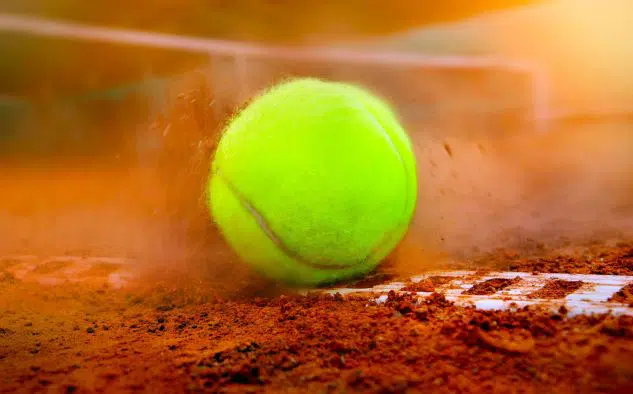Tennis balls and baseballs represent two of the most iconic ball sports, though they have distinct qualities in terms of size, weight, materials, speed, bounce, and specifications. Here are 11 ways tennis balls and baseballs differ:
- Weight – Tennis balls are 57-59g, baseballs 142-149g.
- Size – Tennis balls 6.5-6.7cm diameter, baseballs 7.2-7.4cm.
- Bounce – Tennis balls bounce higher with more deformation.
- Materials – Tennis uses rubber/felt, baseballs have wool or cork centers.
- History – Tennis balls from the 1500s, baseballs from the 1840s.
- Speed – Tennis serves exceed 160mph, baseballs off the bat top 100mph.
- Spin – Tennis balls take heavy topspin, baseballs travel relatively straight.
- Records – Fastest tennis serve is 163.4mph, baseball pitch 105.1mph.
- Brands – Wilson, Penn big in tennis; Rawlings dominates baseballs.
- Storage – Tennis balls lose pressure, baseballs just degrade over time.
- Cost – Pack of tennis balls $5, baseballs $10+ each.
Below we’ll detail all the differences between these iconic spherical sports balls to appreciate how they uniquely suit their specific games!

Difference in Weight
Right away there’s a substantial weight difference – baseballs tip the scales around 145 grams on average. Tennis balls are featherlight at just 57-59 grams.
The heavier baseball provides mass for momentum and distance. The light tennis ball helps acceleration off the racket.
Difference in Size
Baseballs have a diameter around 7.2-7.4 cm, slightly larger than tennis balls at 6.5-6.7 cm.
Baseball’s larger spherical footprint contributes to its heavier weight and solid contact feel. But tennis balls generate great pace for their small size.
Difference in Bounce
Tennis balls have a high, lively bounce off the court thanks to their rubber core and fuzzy felt coating that deforms on impact.
Baseballs bounce relatively stiffly on the field due to their tight wool or cork centers. But tennis balls really kick up off the racket.
Difference in Materials
Modern tennis balls consist of a pressurized inner rubber core wrapped in a fuzzy felt exterior made of hair and cotton fibers.
Baseballs feature a small cork or rubber center pill, wrapped tightly in windings of wool or polyester yarn, with a leather or synthetic hide cover.
So tennis balls favor a light bounce, while baseballs prioritize mass and durability for the demands of the game.
History of Both Ball Types
Tennis balls evolved from wooden to rubber cores enclosed in felt over centuries of materials innovation, dating back to the 1500s.
Early baseballs originated as literal balls of rolled or wrapped string in the 1840s before rubber and cork centers emerged around 1910.
Each ball developed in conjunction with advancements in their sport equipment technology over history.
Speed They Travel
Well-struck tennis serves can exceed 160 mph thanks to the racket’s leverage and a featherlight fuzz ball.
The fastest baseball pitch is around 105 mph, but balls off wooden bats top 100 mph due to the heavier mass limiting bat speed.
So the light tennis ball achieves substantially faster speeds off the flexible racket face.
How Fast is a Serve/Pitch?
- Elite tennis serves range from 115-145+ mph on the professional tours.
- Peak baseball pitching speeds are typically 90-105 mph in the pros.
Tennis racquet acceleration outpaces a pitcher’s arm speed.
World Speed Records
- Fastest tennis serve: 163.4 mph, from John Isner
- Fastest baseball pitch: 105.1 mph, by Aroldis Chapman
That nearly 60 mph difference demonstrates the contrasting ball speeds.
Spin and Flight Characteristics
The felt of tennis balls allows for heavy topspin and slice spins. Baseball trajectories are relatively straight, with occasional tumbling seams.
Tennis requires spin to control directional placement. Baseball priorities optimizing carry distance.
Brands and Manufacturers
Wilson, Penn, Dunlop, Babolat lead tennis ball production. Rawlings overwhelmingly dominates baseball manufacturing.
Both sports benefit from major brands investing in optimized ball designs.
Storage and Maintenance
Tennis balls lose internal pressure over time so需要 rotation to maintain bounce. Baseball integrity declines but doesn’t require inflation.
So tennis balls have a shorter peak lifespan before going flat.
Cost Considerations
Packs of 3 tennis balls can cost as little as $2 per ball. High-grade baseballs are $10+ each, or $100+ per dozen.
The baseball’s intricacy requires higher replacement cost. Tennis balls are an affordable sports staple.
In summary, specialized designs make tennis balls and baseballs ideal for their respective sports – one for speed, spin and bounce, the other for mass and resilience to endure hits. Understanding their contrasts illuminates the engineering inside!
